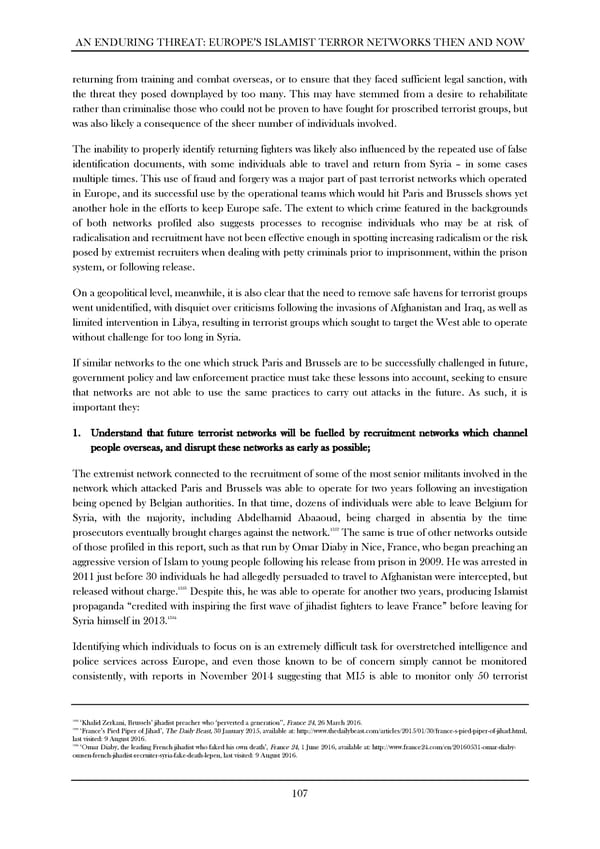AN ENDURING THREAT: EUROPE’S ISLAMIST TERROR NETWORKS THEN AND NOW returning from training and combat overseas, or to ensure that they faced sufficient legal sanction, with the threat they posed downplayed by too many. This may have stemmed from a desire to rehabilitate rather than criminalise those who could not be proven to have fought for proscribed terrorist groups, but was also likely a consequence of the sheer number of individuals involved. The inability to properly identify returning fighters was likely also influenced by the repeated use of false identification documents, with some individuals able to travel and return from Syria – in some cases multiple times. This use of fraud and forgery was a major part of past terrorist networks which operated in Europe, and its successful use by the operational teams which would hit Paris and Brussels shows yet another hole in the efforts to keep Europe safe. The extent to which crime featured in the backgrounds of both networks profiled also suggests processes to recognise individuals who may be at risk of radicalisation and recruitment have not been effective enough in spotting increasing radicalism or the risk posed by extremist recruiters when dealing with petty criminals prior to imprisonment, within the prison system, or following release. On a geopolitical level, meanwhile, it is also clear that the need to remove safe havens for terrorist groups went unidentified, with disquiet over criticisms following the invasions of Afghanistan and Iraq, as well as limited intervention in Libya, resulting in terrorist groups which sought to target the West able to operate without challenge for too long in Syria. If similar networks to the one which struck Paris and Brussels are to be successfully challenged in future, government policy and law enforcement practice must take these lessons into account, seeking to ensure that networks are not able to use the same practices to carry out attacks in the future. As such, it is important they: 1. Understand that future terrorist networks will be fuelled by recruitment networks which channel ! people overseas, and disrupt these networks as early as possible; The extremist network connected to the recruitment of some of the most senior militants involved in the network which attacked Paris and Brussels was able to operate for two years following an investigation being opened by Belgian authorities. In that time, dozens of individuals were able to leave Belgium for Syria, with the majority, including Abdelhamid Abaaoud, being charged in absentia by the time 1352 prosecutors eventually brought charges against the network. The same is true of other networks outside of those profiled in this report, such as that run by Omar Diaby in Nice, France, who began preaching an aggressive version of Islam to young people following his release from prison in 2009. He was arrested in 2011 just before 30 individuals he had allegedly persuaded to travel to Afghanistan were intercepted, but 1353 released without charge. Despite this, he was able to operate for another two years, producing Islamist propaganda “credited with inspiring the first wave of jihadist fighters to leave France” before leaving for 1354 Syria himself in 2013. Identifying which individuals to focus on is an extremely difficult task for overstretched intelligence and police services across Europe, and even those known to be of concern simply cannot be monitored consistently, with reports in November 2014 suggesting that MI5 is able to monitor only 50 terrorist ! ! 1352 ‘Khalid Zerkani, Brussels’ jihadist preacher who ‘perverted a generation’’, France 24, 26 March 2016. 1353 ‘France’s Pied Piper of Jihad’, The Daily Beast, 30 January 2015, available at: http://www.thedailybeast.com/articles/2015/01/30/france-s-pied-piper-of-jihad.html, last visited: 9 August 2016. 1354 ‘Omar Diaby, the leading French jihadist who faked his own death’, France 24, 1 June 2016, available at: http://www.france24.com/en/20160531-omar-diaby- omsen-french-jihadist-recruiter-syria-fake-death-lepen, last visited: 9 August 2016. ! ! 107 !
 An Enduring Threat: Europe’s Islamist Terror Networks Then and Now Page 112 Page 114
An Enduring Threat: Europe’s Islamist Terror Networks Then and Now Page 112 Page 114